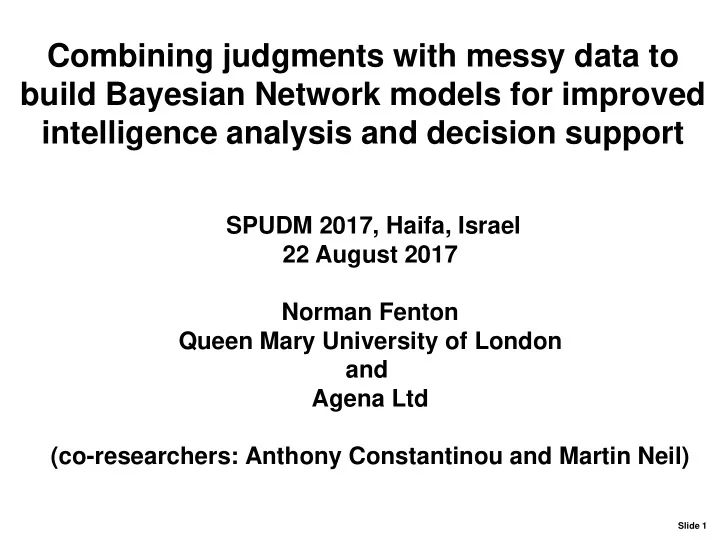

Combining judgments with messy data to build Bayesian Network models for improved intelligence analysis and decision support SPUDM 2017, Haifa, Israel 22 August 2017 Norman Fenton Queen Mary University of London and Agena Ltd (co-researchers: Anthony Constantinou and Martin Neil) Slide 1
Overview • The power – and limitations – of Bayesian networks • Building the models: the fundamental limitations of big data and machine learning Slide 2
A typical Bayesian Network (BN) Each node represents an uncertain variable that may or may not be observed Conditional probability tables on each node capture dependence relations Slide 3
A typical Bayesian Network (BN) Marginal probability calculated (no observations in model) Slide 4
A typical Bayesian Network (BN) Multiple sources of evidence that there is a real threat So how can probability of attack decrease ? Slide 5
A typical Bayesian Network (BN) Because, based on the observational data and expert judgment on which model is defined, it is very likely plotters will be So BN predictions already incorporate likely arrested when we have this decisions . But what if we want to make decisions? kind of evidence Slide 6
A typical Bayesian Network (BN) Where we observe no arrest under such circumstances the probability of an attack increases substantially. But this is an observation and not an intervention . Standard BN does not support correct inference for interventions Slide 7
Need Bayesian Influence Diagram Decision nodes (fundamentally different from chance nodes) Enables us to determine optimal decision at each Utility nodes stage given information available Slide 8
A BN Model learnt purely from data Age Brain scan result Injury type Outcome Delay in Arterial arrival pressure Pupil dilation Slide 9
Expert causal BN with hidden explanatory and intervention variables Arterial Injury pressure type Brain scan Delay in result arrival Pupil Seriousness dilation of injury Ability to Age recover Treatment Outcome Slide 10
Model Objectives Bayesian Network Structure Determine Determine model Define the BN information required Method for objective structure for objective Data developing Management Review questionnaire and interviewing data BNs and Influence Multiple data Gathered Sufficient Excessive No variables for single data for all Yes data Yes statistical model factor? model factors? instances? sampling? diagrams from Yes No No Yes No Introduce synthetic incomplete Formulate composite variables and/or Expand variable state data variables reduce number of granularity states and messy Manage mutual exclusivity data Interventional Parameter Assign expert probabilities to Modelling Learning unknown CPTs Missing Learn CPTs from data No values found in dataset? Perform parameter Perform graph Model requires Yes learning with EM Yes surgery interventions? algorithm Constantinou A., Fenton N., Marsh W, and Radlinski L. , No “ From complex questionnaire and Structural Validation interviewing data to intelligent Bayesian Evaluate model with experts network models for medical decision No support.,” Artif. Intell. Med. , vol. 67, pp. 75 – 93, Satisfied Satisfied Satisfied Perform predictive Jan. 2016. with model Yes with model Yes with model validation structure? factors? performance? No No Model Usage Yes Perform decision Slide 11 analysis
Big Data … or Smart Data? machine learning causal models Knowledge Slide 12
Conclusions BNs provide excellent basis for prediction in intelligence analysis Extension to influence diagrams needed for interventions and decision making The challenge of building effective BN models and influence diagrams will NOT be solved by big data and machine learning We need effective methods to incorporate expert judgment with available data Smart data – not big data Slide 13
Follow up BARD Project Get the book BayesianRisk.com BAYES-KNOWLEDGE Try the free software bayes-knowledge.com and models AgenaRisk.com Slide 14
Recommend
More recommend